Malachy Tallack delves into the world of Shetland artist Paul Bloomer
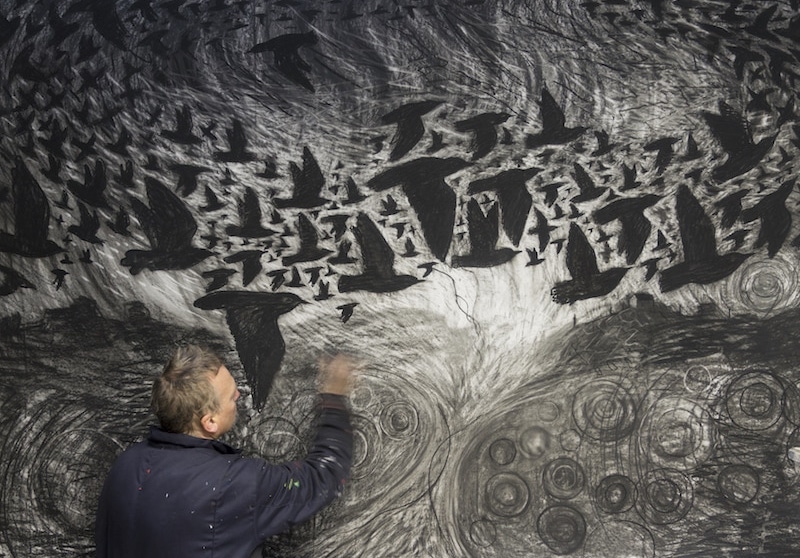
Whenever I go back to Shetland, there are a few things I need to do: minor rituals of reacquaintance that allow me to feel, for the time that I am there, at home again. For the most part, these rituals are barely deserving of the name. There are certain people I like to visit, and certain places I like to see. These places don’t take much viewing. Just a glance can be enough, aligning memory with reality, confirming something I know but could never hope to articulate.
One of these rituals though — performed as often as seems polite — is to visit the artist Paul Bloomer in his studio, to see what he’s been working on, and to be amongst the things he creates. This, too, is a kind of confirmation.
Paul’s studio lies in the village of Bigton, in the south end of Shetland. It is a grey, featureless building that from the outside could be almost anything: an agricultural shed, a boat-builder’s workshop, a long-forgotten storeroom. The absence of windows suggests gloom, but inside is overflowing with colour. Vermillion, turquoise, cobalt blue. Unfinished paintings hang or lean against the walls; completed ones are slotted into racks that reach up to the ceiling. Flat surfaces are buried beneath sketches and woodblocks and bottles of pigment. Everywhere there is work: not just in the sense of things made, but of labour, of striving, of the urgent effort to achieve something.
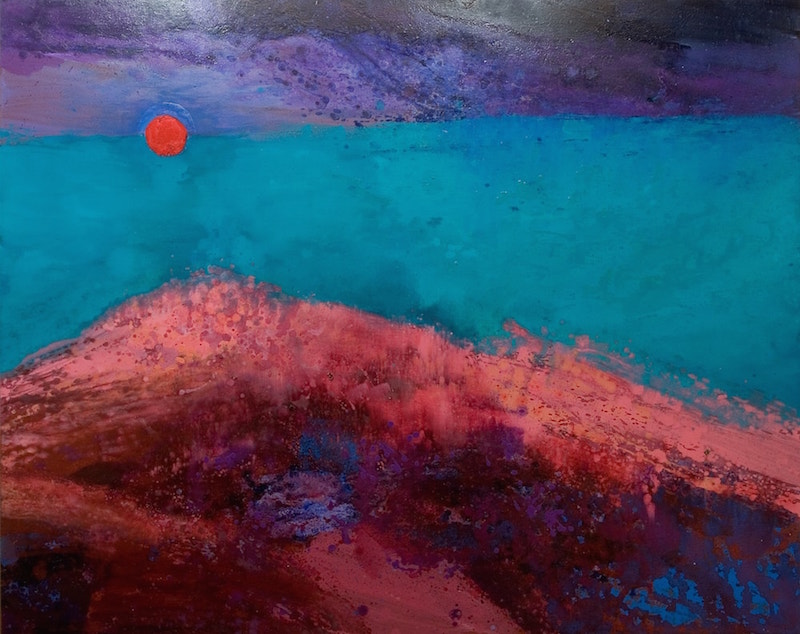
That something, for Bloomer, is the expression of self in place. He draws and paints what he sees, what he feels, what he dreams about; and almost all of it is centred here, in Shetland. It is both framed by this place and filtered through it, like the light strained through the mist in summer.
For an hour or so we take small steps around the room. I look, and he tells me what I’m looking at, what he’s trying to do. Sometimes that purpose is clear in his mind. Other times it is as though he is pushing towards some unseen destination, where motive and meaning will reveal themselves beneath his hands. He has, I think, a deep faith in instinct.
Depending on when I visit, Bloomer’s most recent work may consist of paintings, woodcuts, etchings, drawings, or any combination of these. He is, too, a superb photographer, and has experimented with digital art. He is restless, it seems to me, unwilling ever to settle on one means of expression, of engaging with the world. And yet, throughout, his work maintains a signature gaze, and a style or styles that are recognisably his own.
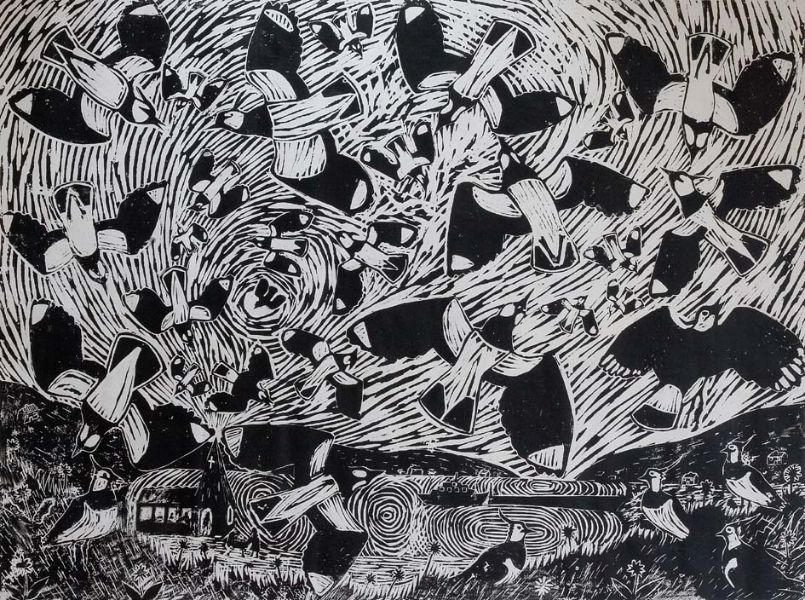
Across these various media, Bloomer returns again and again to certain images and motifs. He often paints the same place — St Ninian’s Isle, not far from where he lives — and the same species of birds recur: lapwings, curlews, geese, swans. These are important for how they look — for their shape and for their movement — but also for how they speak of this place. Like my own returns, these repetitions are a visual and spiritual anchoring. They are each a kind of homecoming. It is a home that he, like me, has had to learn.
Bloomer came to know Shetland only as an adult. He grew up in the urban, industrial Black Country, a place that could hardly be more different, and his early etchings and woodcuts reflect that contrast. They are dark, almost chaotic, despite the exactitude of their composition. They are reminiscent at times of Peter Howson’s work: swollen figures, crammed and jostling for attention.
Compared to these, Paul’s later, Shetland prints are quieter. They are rhythmical, looping, elegant. They depict birds, often in flight; and despite their broad, black lines, they seem always to rise towards light and lightness. They have — and I use this word deliberately — a grace. They are composed, like prayers, with a direction in mind.
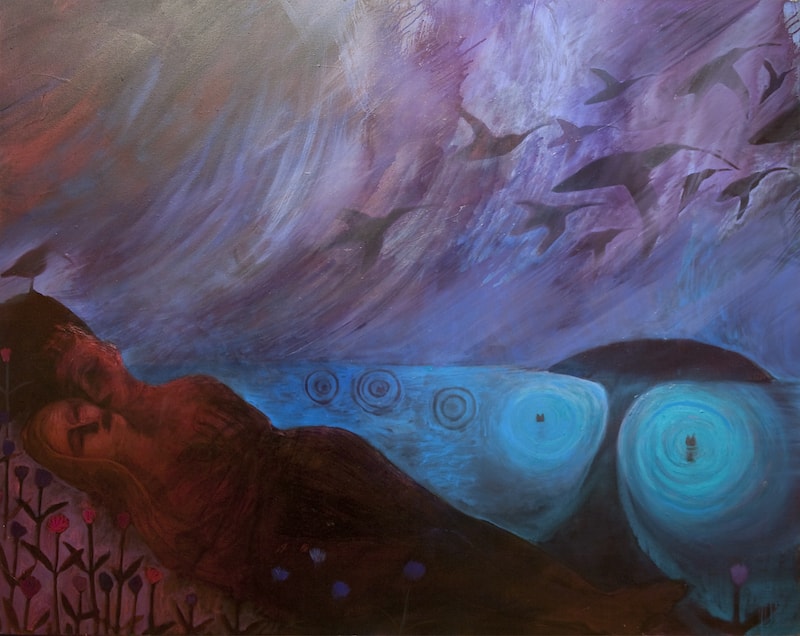
His paintings, too, reflect this sense of direction, but their movement more often seems inward. They hold points of calm, towards which the rest of the picture leans. A figure or figures in a boat; a single islet in a wide expanse of water; the concentric ripples where a fish has touched the surface. It is as if these paintings are meant to be heard as well as seen. They carry the sighs of summer lochs.
While nearly all of his pictures now are centred in Shetland — or in some imagined version of this place — Bloomer’s colour palette is not what one might immediately associate with the islands. He uses greens sparingly, instead employing vivid reds, blues and purples. Sometimes a single colour will dominate, pushing everything else aside. The effect can be striking and surprising. And yet, even at his boldest and brightest, there is always some hint of darkness here, and the shadow of lingering doubt.
On my last visit to Paul’s studio, I went specifically to see one new painting, called Water Song. I had seen a photograph online, but wanted to get closer. It was a large canvas, familiar, in colour and motif, from previous work. A shoal of fish was visible in the bottom half — dark shapes beneath the water — and a little holm lay at the centre of the image, with splashes of wild flowers upon it. The paint was dusky blue around the edges, but brightened towards that centre, where a column of icy cerulean descended, so dazzling it seemed almost to glow. Everything in the room, I felt, was inclined towards that tiny island, like a family around a fire. Standing there in front of it, unable to look away, the painting took the breath from me.
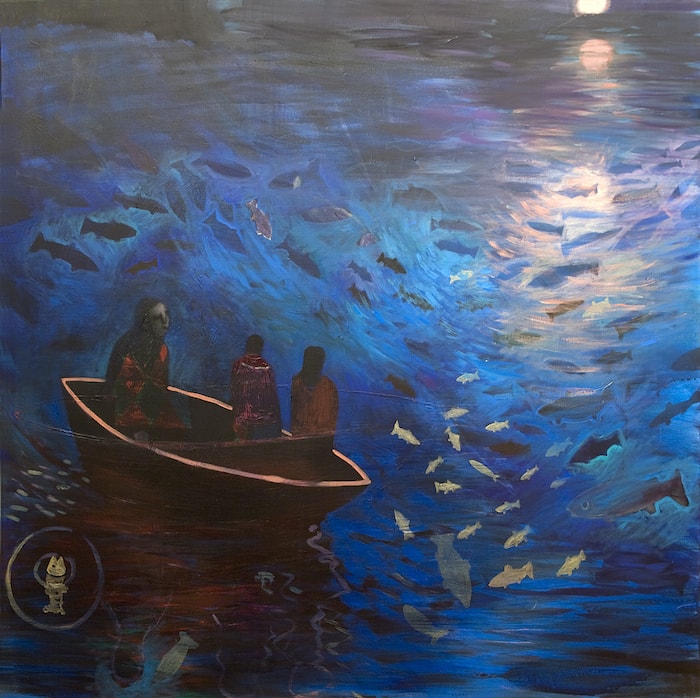
The reason I return so often to Paul Bloomer’s work isn’t that his vision of Shetland aligns perfectly with mine. It does not. His focus, and his expression of that focus, are his alone, and there are times when I find myself unmoved by it. But even in those cases where an image or a series of images do not chime with me at all, his project and purpose always resonate. His work feels in conversation with my own thoughts. It takes seriously the questions that I, too, am troubled by.
Throughout this work, I find, there is a hopeful kind of melancholy, like a song of home heard while far away at sea. Ardent, earnest, it pulls at me, drawing me inward, drawing me back. Those points of calm in his paintings are like promises, and I cannot help but believe them. Always, I leave his studio lightened.
*
More of Paul’s work can be found here.
Malachy Tallack is the author of three books, most recently The Valley at the Centre of the World (Canongate), 2018. Malachy’s website/Twitter account